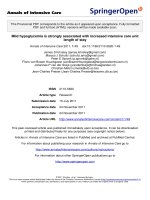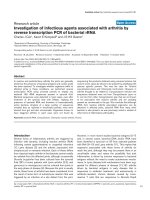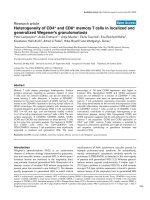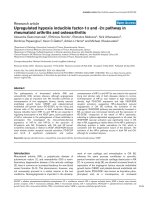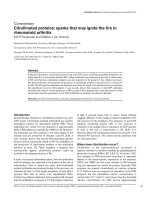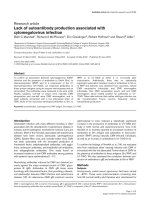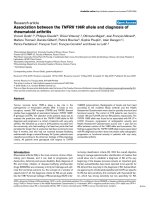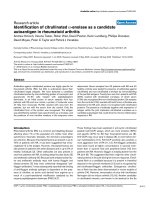Báo cáo y học: "TRAF1/C5 polymorphism is not associated with increased mortality in rheumatoid arthritis: two large longitudinal studies" pot
Bạn đang xem bản rút gọn của tài liệu. Xem và tải ngay bản đầy đủ của tài liệu tại đây (312.11 KB, 7 trang )
RESEARC H ARTIC LE Open Access
TRAF1/C5 polymorphism is not associated with
increased mortality in rheumatoid arthritis: two
large longitudinal studies
Jessica AB van Nies
1*
, Rute B Marques
1
, Stella Trompet
2,3
, Zuzana de Jong
1
, Fina AS Kurreeman
1
, Rene EM Toes
1
,
J Wouter Jukema
2
, Tom WJ Huizinga
1
, Annette HM van der Helm-van Mil
1
Abstract
Introduction: Recently an association between a genetic variation in TRAF1/C5 and mortality from sepsis or cancer
was found in rheumatoid arthritis (RA). The most prevalent cause of death , cardiovascular disease, may have been
missed in that study, since patients were enrolled at an advanced disease stage. Therefore, we used an inception
cohort of RA patients to investigate the association between TRAF1/C5 and cardiovascular mortality, and replicate
the findings on all-cause mortality. As TRAF1/C5 associated mortality may not be restricted to RA, we also studied a
large cohort of non-RA patients.
Methods: 615 RA patients from the Leiden Early Arthritis Clinic (EAC) (mean follow-up 7.6 years) were genotyped
for rs10818488. In addition 5634 persons enrolled in the PROspective Study of Pravastatin in the Elderly at Risk
(mean follow-up 3.2 years) were genotyped for rs24 16808 (R
2
>0.99 with rs10818488). The life/death status was
determined and for the deceased persons the cause of death was ascerta ined. Cox proportional hazards and
regression models were used to assess hazard ratios (HR) and 95% confidence intervals (CI).
Results: Seventy-seven RA patients died. The main death cause s in RA patients were cardiovascular diseases
(37.7%), cancer (28.6%) and death due to infections (9.1%). No association was observed between the rs10818488
susceptible genotype AA and cardiovascular mortality (HR 1.08 95%CI 0.54 to 2.15) and all-cause mortality (HR 0.81
95%CI 0.27 to 2.43). Similar findings were observed for rs2416808 susceptible genotype GG in the non-RA cohort
(HR 0.99; 95%CI 0.79 to 1.25 and HR 0.89; 95%CI 0.64 to 1.25, respectively).
Conclusions: The TRAF1/C5 region is not associated with an increased mortality risk.
Introduction
Patients with rheumatoid arthritis (RA) have an
increased mortality risk. A recent re view, studying data
from 84 unique cohorts, showed that mortality rates in
RA patients were 1.5 to 1.6 fold higher than in the gen-
eral population [1]. The attributed causes of death in
RA patients are identical to those in the general popula-
tion [1], cardiovascular disease being the primary cause
of death followed by cancer and infection. Age, sex and
most clinical markers that are related to a more severe
destructive disease course (among others number of
inflamed joints, C reactive protein (CRP) and presence
of erosions) are also associated with higher mortality
risks [1].
Genetic risk factors for mortality in RA are scarcely
investigated. Presence of the human leukocyte antigen
(HLA)-DRB1 shared epitope alleles are reported to be
associated with an increased mortality and, in particular,
mortality r elated to cardiovascular disease (CVD) [2-4].
Although a lot of progress has been made in the field of
genetics of RA-susceptibility, the HLA-shared epitope
alleles still constitute the most powerful genetic risk fac-
tor to developing RA. Well-replicated non-HLA risk fac-
tors are PTPN22, TNFAIP3,andTRAF1/C5 [5-7].
TRAF1/C5 associated with several autoimmune diseases
other than RA such as juvenile idiopathic arthritis (JIA)
and systemic lupus erythomatodes [8,9].
* Correspondence:
1
Department of Rheumatology, Leiden University Medical Centre,
Albinusdreef 2, 2333 ZA Leiden, The Netherlands
van Nies et al. Arthritis Research & Therapy 2010, 12:R38
/>© 2010 van N ies et al.; licensee BioMed Central Ltd. This is an open access article distributed under the t erms of the Creative Commons
Attribution License ( which permits unrestricted use, distribution, and reproduction in
any medium, provided the original work is properly cited .
A recent study analyzed the TRAF1/C5 variant,
rs3761847, in relation to mortality in RA and observed
an increased mortality risk for the susceptible genotype
GG compared with the non-susceptible AA genotype
(hazard ratio (HR) = 3.96, 95% confidence interval (CI) =
1.24 to 12.6) [10]. Such an observation is relevant because
it indicates that genetic factors, such as TRAF1/C5,con-
tribute to the increased mortality in RA. The causes of
death were also investigated. Intriguingly, no increased
death rate for CVD was found among GG homozygotes,
whereas increased death rates were found for cancer and
infections. As this study enrolled patients with a median
disease duration of 10 (range 4 to 18) years, which were
subsequently followed up for two to four years, CVD-
related deaths occurring earlier in the disease course may
have been missed. To further explore the association
between the TRAF1/C5 locus and CVD-related mortality
in RA, we studied a cohort of 615 early RA patients that
were followed from disease onset to 14 years onwards. In
addition, we investigated whether the association with
all-cause, infectious and cancer-related mortality Panou-
las and colleagues observed could be replicated [10].
Finally, as an association between TRAF1/C5 and mortal-
ity may not be re stricted to RA patients, we also analysed
a large cohort of non-RA patients.
Materials and methods
Early arthritis clinic cohort
The Leiden early arthritis cohort (EAC) is an inception
cohort consisting of patients with recent-onset arthritis
referred to the Department of Rheumatology of the Lei-
den University Medical Center from 1993 onw ards [11].
Patients were included when arthritis was observed by a
rheumatologist. For the present study, patients were
selected who fulfilled the American College of Rheuma-
tology 1987 revised criteria for RA within the first year
of follow up and had DNA samples available (n = 615)
[12]. Written informed consent was obtained from all
participants. The study was approved by the appropriate
local institutio nal review board. At inclusion, a physical
examination was performed and blood samples were
taken to determine CRP, immunoglobulin (Ig) M rheu-
matoid factor (RF; by ELISA) and anti-cyclic citrulli-
nated peptide (CCP) 2 antibodies (Immunoscan RA
Mark 2; Euro-Diagnostica, Arnhem, the Netherlands).
Anti-CCP2 positivity had a cut-off level of 25 arbitr ary
units, according to manufacturer’ s instructions. Patients
also filled in a Health Assessment Questionnaire (HAQ)
[13] and radiographs of hands and feet were taken and
scored by one experienced reader (the intraclass-obser-
ver correlation coefficie nts was 0.91), using the Sharp-
van der Heijde method [14].
Cohort of non-RA patients
As well as the RA patients, 5634 participants with available
DNA from the PROspective Study of Pravastatin in the
Elderly at Risk (PROSPER) were studied. In short, PROS-
PER is a randomized double-blind placebo-controlled trial
that assessed whether pravastatin treatment in elderly men
and women dimini shed the risk of major vascular events
[15]. Participants were screened and enrolled in Scotland
(Glasgow), Ireland (Cork), and the Netherlands (Leiden)
between December 1997 and May 1999. Written informed
consent was obtained from all participants. The study was
approved by the appropriate local institutional review
boards of all centers. The primary endpoint in the study
was a combination of death from coronary heart disease
(CHD), non-fatal myocardial infarction (MI), and fatal or
non-fatal stroke. After three years of follow up, CVD and
transient ischemic attacks (TIAs) were less prevalent in
the group treated with pravastatin [16].
SNP genotyping
rs10818488 was genotyped in the RA cohort and
rs2416808, which is in complete linkage disequilibrium
with rs10818488 (r
2
>0.99) , was genotyped in the non-RA
cohort. Genotypings were performed using the MassArray
matrix-assisted laser desorption ionisation time-of-flight
mass spectrometry, according to the protocols recom-
mended by the manufacturer (Sequenom, San Diego, CA,
USA). Each 384-well plate contained at least 4 positive
(CEPH DNA) and 4 negative controls, to check for assay
performance and contaminations, respect ively. Spectro-
Caller software (Sequenom, San Diego, CA, USA) supplied
by the manufacturer was used to automatically identify the
genotypes. Clusters were checked and all doubtful calls
were manually evaluated. Ten percent of the genotypes
were performed in duplicate and the error rate was below
1%. Allele frequencies and Hardy-Weinberg equilibrium
consistency were determined with Haploview [17]. Both
SNPs were in ag reement wit h Hardy-Weinb erg equili-
brium. Both rs10818488 and rs2416808 are in complete
linkage-disequilibrium with rs3761847 genotyped by
Panoulas and colleagues (r
2
>0.99 data from Hapmap, and
Kurreeman and colleagues) [5,6,10].
Notification of death
In the EAC, patients were followed longitudinally from
the moment of their inclusion until 1 April , 2008, or
death. All RA patients were tracked nationally using the
civic registries (Gemeenteli jke Basis Administratie) to
ascertain life or death status. Causes of death for RA
patients were obtained from Statistics Netherlands [18]
and coded according to the International Classification
of Diseases 10
th
revision of the World Health
van Nies et al. Arthritis Research & Therapy 2010, 12:R38
/>Page 2 of 7
Organization [19]. In the non-RA cohort, patients were
followed for 3.2 years and the c auses of death in this
period were obtained from post-mortem reports and/or
certification of deat h. All endpoints were adjudicated by
a study endpoint committee.
Analysis of data
Data are expressed as mean (± standard deviation (SD))
with a 95% CI for continuous variables and as propor-
tions for categorical variables. Differences in baseline
patient characteristics between the single nucleotide
protocol (SNP) genotypes were compared using a one-
way analysis of variance test or Kruskal Wallis test for
continuous variables and the chi-squared test for nom-
inal variables. Associations between genotype and mor-
tality were tested with univariate cox regression analyses
and log rank tests.
In a study in RA patients (unpublished) we observed
that age, CRP level and Sharp-van der Heijde score were
independently associated with mortality. In order to
investigate whether TRAF1/C5 is associated with mor-
tality after adjusting for gender, HAQ-score and other
previously found risk factors, a multivariate cox regres-
sion analysis was performed.
Subjects from the c ohort of non-RA patients who
withdrew consent or died during the study were cen-
sored at the date of death or at the last date of follow
up. Cox regression analyses in the cohort of non-RA
patients were adjusted for gender, age, pravastatin or
placebo use, and country.
Panoulas and colleagues o bserved a HR of 3.96. The
RA cohort has a power of 99.6% to identify such an
association with C5/TRAF1 based on the observed geno-
type frequencies and an alpha of 0.05. In the non-RA
cohort this power was 100%. Assuming that the finding
by Panoulas and colleagues was affected by the winners
curse and the true HR wou ld be lower, for example a
HR of 1.5, then the power of the RA c ohort and non-
RA cohort to observe an association was 28% and
97.5%, respectively.
All statistical analyses were performed using Statistical
Package for Social Sciences version 16.0 ( SPSS, Chicago,
IL, USA). In all tests, P values below 0.05 were consid-
ered to be significant.
Results
Baseline characteristics
The 615 RA patients had mean (± SD) age of 56.4 ±
15.6 years and 68.5% were female. The mean CRP con-
centration was 29.5 ± 33.1 mg/L, 57% were RF positive,
43.4% were anti-CCP2 positive, the mean HAQ score
was 1.07 ± 0.72 and the median Sharp-van der Heijde
scoreatbaselinewas6(range2to12).Thegenotype
frequencies for rs10818488 were: 29% GG (n = 180),
53% AG (n = 324) and 18% AA (n = 111). No differ-
ences in baseline characteristics between genotypes were
observed (Table 1). The mean follow up was 7.6 ± 3.6
years (range 4.7 to 10.5 years).
In the cohort o f non-RA patients 51.6% were female
and the mean age was 75.3 ± 3.4 years. For baseline
characteristics see Table 2. The slight difference in his-
tory of stroke was considered to be a spurious finding
due to multiple comparisons. The genotype frequencies
for rs2416808 were: 30.9% AA (n = 1743), 48.4% AG
(n = 2725) and 19.9% GG (n = 1123). The mean follow
up in these patients was 3.2 ± 0.6 years.
Mortality in RA cohort
Seventy-seven RA patients died during follow up; 46
(11%) women and 31 (16%) men. Twenty-five percent of
these patients carried the GG genotype, 57% the AG gen-
otype and 18% the AA genotype. The survival probability
of rs10818488 genotypes and all-cause mortality is pre-
sented in Figure 1a. No significant difference in all-cause
mortality was found across the genotypes (HR = 1.06,
95% CI = 0.76 to 1.46, P = 0.752). The major cause of
death in RA patients was attributed to CVD (37.7%). This
was most frequently caused by acute MI and the second
most frequent cause of CVD-re lated mortality was heart
failure. Besides CVD, two other major causes of death in
RA patients were cancer (28.6%; n = 22), most frequently
of the bronchus and lungs, and infection (9.1%; n = 7).
The 29 patients who died due to CVD had the follow-
ing genotypes for rs10818488: 31% GG homozygotes,
52% AG heterozygotes and 17% AA homozygotes. Survi-
val probability of CVD-related mortality i s presented in
Figure 1b. Also, here no significant difference was found
between the three genotypes (HR = 0.91, 95% CI =
0.53-1.54, P = 0.713; Table 3).
Multivariate cox regression analyses were performed to
assess whether the TRAF1/C5 susceptible genotype was
associated with mortality after adjustments for other
known risk factors for mortality. Also after adjustments,
no significant association between rs10818488 genotype
and all-cause (HR = 0.91, 95% CI = 0.61 to 1.37), cardio-
vascular (HR = 0.97, 95% CI = 0.54 to 1.76), cancer (HR =
0.66, 95% CI = 0.28 to 1.56) or infectious-related mortality
(HR = 0.54, 95% CI = 0.09 to 3.13) was observed.
Mortality in non-RA cohort
In the non-RA c ohort, 586 participants died, 32% were
AA homozygote, 48% AG heterozygote and 20% G G
homozygote for rs2416808. Also, no significant associa-
tion was found between the TRAF1/C5 variants and all-
cause mortality (HR = 0.99 , 95% CI = 0.89 to 1.11),
CVD-related (HR = 0.95, 95% CI = 0.80 to 1.12) and
cancer-related mortality (HR = 1.00, 95% CI = 0.82 to
1.21; Table 3). Analyzing only the placebo-treated group
van Nies et al. Arthritis Research & Therapy 2010, 12:R38
/>Page 3 of 7
did not change the results (data not shown). Similarly,
also in the non-RA cohort after adjustments, no signifi-
cant association was found between rs2416808 and all-
cause (HR = 0.99, 95% CI = 0.88 to 1.11), cardiovascular
(HR = 0.94, 95% CI = 0.80 to 1.11) or cancer-related
mortalities (HR = 1.00, 95% CI = 0.82 to 1.22) in a mul-
tivariate cox regression analysis.
Discussion
The present study was performed to investigate the rela-
tion between a well-replicated genetic RA susceptibility
factor, TRAF1/C5, and the mortality risk in a cohort of
RA pa tients. No evidence for an association of this risk
factor with mortality was observed.
Panoulas and colleagues recently observed an
increased mortality risk for carriers of the TRAF1/C5
susceptibility risk genotype in RA patients [10]. Both
polymorphisms analyzed in the present study,
rs10818488 and rs2416808, are in complete linkage-dise-
quilibrium with the rs3761847 SNP genotyped by
Panoulas and colleagues (r
2
>0.99 data from Hapmap,
and Kurreeman and colleagues) [5,6]. However, we
could not replicate their finding, despite having a larger
cohort (615 vs 400 RA patients), a longer follow-up
duration (mean 7.6 vs 2.6 years) and a higher number of
events (77 vs 23 deaths). In addition, Panoulas and col-
leagues reported an increased risk of death due to can-
cer and sepsis, but not CVD. It is possible that the
Table 1 Baseline characteristics of the RA patients per genotype of rs10818488
GG
n = 180 (29%)
AG
n = 324 (53%)
AA
n = 111 (18%)
Age (years) 56.2 ± 15.2 56.3 ± 15.5 57.3 ± 16.5
Females, n (%) 132 (73.3) 218 (67.3) 71 (64.0)
Past or current smoker, n (%) 83 (51.2) 139 (48.1) 53 (54.1)
Swollen joint count 9.0 ± 6.6 9.4 ± 7.3 8.0 ± 6.0
BMI (kg/m
2
) 25.5 ± 3.7 25.7 ± 3.8 25.7 ± 4.0
RF positive, n (%) 101 (57.1) 181 (57.3) 70 (63.6)
Anti-CCP positive, n (%) 75 (56.4) 146 (57.5) 46 (51.7)
CRP (mg/L) 28.1 ± 29.0 31.6 ± 36.1 25.8 ± 30.1
HAQ (0-3) 1.05 ± 0.70 1.10 ± 0.72 1.03 ± 0.77
Total Sharp- van der Heijde score, median (IQR 25-75) 6 (2-13) 6 (2-12) 5 (1.5-11)
Except if stated otherwise values are mean (standard deviation).
#Data not available for all cases (smoking status n = 66, swollen joint count n = 111, BMI n = 156, rheumatoid factor in n = 12, anti CCP n = 139, CRP n = 46,
HAQ n = 113, Total Sharp- van der Heijde score n = 27).
BMI, body mass inde x; CCP, cyclic citrullinated peptide; CRP, C-reactive protein; IQR, interquartile range; HAQ, Health Assessment Questionnaire; RA, rheumatoid
arthritis; RF, rheumatoid factor.
Table 2 Baseline characteristics of the non-RA patients per genotype of rs2416808
AA
n = 1783 (32%)
AG
n = 2725 (48%)
GG
n = 1123 (20%)
Age (years) 75.24 (3.35) 75.39 (3.31) 75.35 (3.45)
Females, n (%) 898 (50) 1427 (52) 582 (52)
Current smoker, n (%) 459 (26) 738 (27) 311 (28)
BMI (kg/m
2
) 26.85 (4.13) 26.85 (4.19) 26.76 (4.28)
Systolic blood pressure (mmHg) 154.36 (21.18) 154.78 (22.23) 154.89 (21.59)
Diastolic blood pressure (mmHg) 83.65 (11.34) 83.97 (11.45) 83.50 (11.67)
CRP (mg/L) 5.67 (8.65) 5.97 (11.58) 6.13 (13.32)
Total cholesterol (mmol/L) 5.68 (0.90) 5.66 (0.90) 5.74 (0.92)
History of diabetes, n (%) 203 (11) 281 (10) 113 (10)
History of hypertension, n (%) 1093 (61) 1721 (63) 678 (60)
History of myocardial infarction, n (%) 239 (13) 375 (14) 146 (13)
History of stroke or TIA, n (%) 174 (10) 321 (12) 137 (12)*
History of vascular disease, n (%) 770 (43) 1220 (45) 502 (45)
History of angina, n (%) 484 (27) 740 (27) 290 (26)
History of claudication, n (%) 124 (7) 180 (7) 75 (7)
Except if stated otherwise values are mean (standard deviation).
* History of TIA: P value 0.027.
BMI, body mass inde x; CRP, C-reactive protein; RA, rheumatoid arthritis; TIA, transient ischemic attack.
van Nies et al. Arthritis Research & Therapy 2010, 12:R38
/>Page 4 of 7
cohort design from Panoulas and colleagues was less
suitable to study association with CVD-related mortal-
ity, because patients were enrolled at an advanced dis-
ease stage. In this setting, a possible relation between
TRAF1/C5 and cardiovascular mortality may be
missed, because patients dying of CVD earlier in the
disease course are not part of their cohort. This
hypothesis was corroborated by our results in the RA
cohort, which showed that most of the CVD-related
deaths were concentrated in the first 10 years of dis-
ease. However, also in our EAC, no a ssociation was
found between TRAF1/C5 locus and cardiovascular
mortality in RA.
In order to further unravel the eventual associa tion
between TRAF1/C5 locus and mortality, we hypothe-
sised that this risk would not be restricted to RA.
Therefore, we also genotyped TRAF1/C5 in a large
cohort of elderly people that were prospectively followed
in PROSPER. This large cohort was well-powered to
detect also small HR (e.g. 1.5). Nonetheless, TRAF1/C5
did not confer an increased mortality risk.
This strengthened our findings of an absent associa-
tion between TRAF1/C5 and risk of death.
In the end, one might argue that any cohort that
enrolls older participants is inappropriate to stud y mor-
tality, because the risk genotype may cause an early
death. In this sense, prospective studies that follow the
participants ove r a period of decades may be more sui-
table to answer this question. Nevertheless, the
rs10818488 genotype frequencies in our JIA cohort (GG
= 30%, AG = 53%, AA = 17%), which has a mean age of
6.4 years at inclusion, did not differ from the frequen-
cies in the a dult EAC cohort [8]. Also the minor allele
frequency in the non-RA cohort is similar to those in
the general population [20]. In addition, both cohorts
were in agreeme nt with Hardy- Weinberg equilibrium.
This indicates that there was no selection of the protec-
tive genotype in the RA or non-RA cohort. This makes
an early death in t he risk genotype carriers unlikely and
further supports the lack of association of these TRAF1/
C5 variants with mortality.
In the RA-cohort, mortality due to infections were
relativel y infrequent, the number of deaths attributed to
Figure 1 Survival curves for a ll-cause and cardiovascular
mortality in RA patients per genotype of rs10818488. The log
rank tests showed P values for all-cause mortality and cardiovascular
mortality of 0.69 and 0.93, respectively. (a) All-cause mortality. (b)
Cardiovascular mortality. Blue line: GG n = 180. Red line: AG n =
324. Green line: AA n = 111.
Table 3 Hazard ratios for genotypes rs10818488 and
rs2416808 in the RA-cohort and Non-RA cohort in
univariate cox regression analysis
Hazard ratios RA cohort
Trend AA vs GG
Mortality HR(95% CI) P value HR (95% CI) P value
All-cause 1.06 (0.76-1.46) 0.752 1.08 (0.54-2.15) 0.830
CVD 0.91 (0.53-1.54) 0.713 0.81 (0.27-2.43) 0.712
Cancer 0.90 (0.49-1.67) 0.741 0.73 (0.18-2.92) 0.657
Infectious 1.19 (0.41-3.51) 0.748 1.42 (0.09-22.7) 0.803
Hazards ratios non-RA cohort
Trend GG vs AA
Mortality HR (95% CI) P value HR (95% CI) P value
All-cause 0.99 (0.89-1.11) 0.890 0.99 (0.79-1.25) 0.924
CVD 0.95 (0.80-1.12) 0.512 0.89 (0.64-1.25) 0.515
Cancer 1.00 (0.82-1.21) 0.980 1.02 (0.70-1.50) 0.919
CI, confidence interval; HR, hazard ratio; CVD, cardiovascular disease; RA,
rheumatoid arthritis.
van Nies et al. Arthritis Research & Therapy 2010, 12:R38
/>Page 5 of 7
infections is insufficient to make definite conclusions on
the association between TRAF1/C5 and this specific
cause of mortality.
The important causes of death observed in RA
patients in the present study are similar to the main
causes of death in the general Dutch population [18].
The frequency of CVD-related mortality itself is
reported to be higher in RA patients than in healthy
individuals [1]. Result s from the Nurses Health Study
revealed that women with RA had a relative risk of 1.8
for fatal MI [21]. Unfortunately, we were unable to test
whether the frequency of cardiovascular death was also
increased in our EAC RA cohort, because we do not
have mortality information on an age- and gender-
matched Dutch control population.
Conclusions
In conclusion, TRAF1/C5 polymorphisms predisposing
to RA susceptibility are not associated with all-cause
mortality o r cardiovascular- or cancer-related mortality
in RA and in an elderly cohort of persons without RA.
Abbreviations
CCP: cyclic citrullinated peptide; CHD: coronary heart disease; CI: confidence
interval; CRP: C reactive protein; CVD: cardiovascular disease; EAC: early
arthritis clinic; ELISA: enzyme-linked immunosorbent assay; HAQ: health
assessment questionnaire; HLA: human leukocyte antigen; HR: hazard ratios;
Ig: immunoglobulin; JIA: juvenile idiopathic arthritis; MI: myocardial infarction;
PROSPER: PROspective Study of Pravastatin in the Elderly at Risk; RA:
rheumatoid arthritis; RF: rheumatoid factor; SD: standard deviation; SNP:
single nucleotide protocol; TIA: transient ischaemic attack.
Acknowledgements
The authors thank the Dutch Central Bureau for Statistics (CBS) for providing
the data on the survival of the general Dutch population and the death
causes of RA patients. This work is supported by The Netherlands
Organisation for Health Research and Development, Centre for Medical
Systems Biology and the Dutch Arthritis Association and the European
Union-funded FP7-integrated project Masterswitch no. 223404 and
AutoCure.
Author details
1
Department of Rheumatology, Leiden University Medical Centre,
Albinusdreef 2, 2333 ZA Leiden, The Netherlands.
2
Department of
Cardiology, Leiden University Medical Centre, Albinusdreef 2, 2333 ZA
Leiden, The Netherlands.
3
Department of Gerontology and Geriatrics, Leiden
University Medical Centre, Albinusdreef 2, 2333 ZA Leiden, The Netherlands.
Authors’ contributions
RM, FK, ZdJ, JvN and ST made the acquisition of data. JvN, RM, ST and AvdH
carried out the analysis and interpretation of data. JvN, RM, ST and AvdH
have been involved in drafting the manuscript. AvdH, TH, WJ and RT were
responsible for revising critically the manuscript for important intellect ual
content. All authors have given final approval of the version to be
published.
Competing interests
The authors declare that they have no competing interests.
Received: 28 September 2009 Revised: 18 January 2010
Accepted: 5 March 2010 Published: 5 March 2010
References
1. Sokka T, Abelson B, Pincus T: Mortality in rheumatoid arthritis: 2008
update. Clin Exp Rheumatol 2008, 26:S35-S61.
2. Mattey DL, Thomson W, Ollier WE, Batley M, Davies PG, Gough AK, Devlin J,
Prouse P, James DW, Williams PL, Dixey J, Winfield J, Cox NL, Koduri G,
Young A: Association of DRB1 shared epitope genotypes with early
mortality in rheumatoid arthritis: results of eighteen years of followup
from the early rheumatoid arthritis study. Arthritis Rheum 2007,
56:1408-1416.
3. Farragher TM, Goodson NJ, Naseem H, Silman AJ, Thomson W, Symmons D,
Barton A: Association of the HLA-DRB1 gene with premature death,
particularly from cardiovascular disease, in patients with rheumatoid
arthritis and inflammatory polyarthritis. Arthritis Rheum 2008, 58:359-369.
4. Gonzalez-Gay MA, Gonzalez-Juanatey C, Lopez-Diaz MJ, Pineiro A, Garcia-
Porrua C, Miranda-Filloy JA, Ollier WE, Martin J, Llorca J: HLA-DRB1 and
persistent chronic inflammation contribute to cardiovascular events and
cardiovascular mortality in patients with rheumatoid arthritis. Arthritis
Rheum 2007, 57:125-132.
5. Kurreeman FA, Padyukov L, Marques RB, Schrodi SJ, Seddighzadeh M,
Stoeken-Rijsbergen G, Helm-van Mil van der AH, Allaart CF, Verduyn W,
Houwing-Duistermaat J, Alfredsson L, Begovich AB, Klareskog L,
Huizinga TW, Toes RE: A candidate gene approach identifies the TRAF1/
C5 region as a risk factor for rheumatoid arthritis. PLoS Med 2007, 4:e278.
6. Plenge RM, Seielstad M, Padyukov L, Lee AT, Remmers EF, Ding B, Liew A,
Khalili H, Chandrasekaran A, Davies LR, Li W, Tan AK, Bonnard C, Ong RT,
Thalamuthu A, Pettersson S, Liu C, Tian C, Chen WV, Carulli JP, Beckman EM,
Altshuler D, Alfredsson L, Criswell LA, Amos CI, Seldin MF, Kastner DL,
Klareskog L, Gregersen PK: TRAF1-C5 as a risk locus for rheumatoid
arthritis–a genomewide study. N Engl J Med 2007, 357:1199-1209.
7. Helm-van Mil van der AH, Huizinga TW: Advances in the genetics of
rheumatoid arthritis point to subclassification into distinct disease
subsets. Arthritis Res Ther 2008, 10:205.
8. Albers HM, Kurreeman FA, Houwing-Duistermaat JJ, Brinkman DM,
Kamphuis SS, Girschick HJ, Wouters C, Van Rossum MA, Verduijn W,
Toes RE, Huizinga TW, Schilham MW, ten Cate R: The TRAF1/C5 region is a
risk factor for polyarthritis in juvenile idiopathic arthritis. Ann Rheum Dis
2008, 67:1578-1580.
9. Kurreeman FA, Goulielmos GN, Alizadeh BZ, Rueda B, Houwing-
Duistermaat J, Sanchez E, Bevova M, Radstake TR, Vonk MC, Galanakis E,
Ortego N, Verduyn W, Zervou MI, Consortium S, Roep BO, Dema B,
Espino L, Urcelay E, Boumpas DT, Berg van den LH, Wijmenga C,
Koeleman BP, Huizinga TW, Toes RE, Martin J: The TRAF1-C5 region on
chromosome 9q33 is associated with multiple autoimmune diseases.
Ann Rheum Dis 2009.
10. Panoulas VF, Smith JP, Nightingale P, Kitas GD: Association of the TRAF1/
C5 locus with increased mortality, particularly from malignancy or
sepsis, in patients with rheumatoid arthritis. Arthritis Rheum 2009,
60:39-46.
11. van Aken J, van Bilsen JH, Allaart CF, Huizinga TW, Breedveld FC: The
Leiden Early Arthritis Clinic. Clin Exp Rheumatol 2003, 21:S100-S105.
12. Arnett FC, Edworthy SM, Bloch DA, McShane DJ, Fries JF, Cooper NS,
Healey LA, Kaplan SR, Liang MH, Luthra HS, Medsger TA, Mitchell DM,
Neustadt DH, Pinals RS, Schaller JG, Sharp JT, Wilder RL, Hunder GG: The
American Rheumatism Association 1987 revised criteria for the
classification of rheumatoid arthritis. Arthritis Rheum 1988, 31:315-324.
13. Heijde van der DM: How to read radiographs according to the Sharp/van
der Heijde method. J Rheumatol
1999, 26:743-745.
14. Heijde van der DM, van Riel PL, Putte van De LB: Sensitivity of a Dutch
Health Assessment Questionnaire in a trial comparing
hydroxychloroquine vs. sulphasalazine. Scand J Rheumatol 1990,
19:407-412.
15. Shepherd J, Blauw GJ, Murphy MB, Cobbe SM, Bollen EL, Buckley BM, Ford I,
Jukema JW, Hyland M, Gaw A, Lagaay AM, Perry IJ, Macfarlane PW,
Meinders AE, Sweeney BJ, Packard CJ, Westendorp RG, Twomey C, Stott DJ:
The design of a prospective study of Pravastatin in the Elderly at Risk
(PROSPER). PROSPER Study Group. PROspective Study of Pravastatin in
the Elderly at Risk. Am J Cardiol 1999, 84:1192-1197.
16. Shepherd J, Blauw GJ, Murphy MB, Bollen EL, Buckley BM, Cobbe SM, Ford I,
Gaw A, Hyland M, Jukema JW, Kamper AM, Macfarlane PW, Meinders AE,
Norrie J, Packard CJ, Perry IJ, Stott DJ, Sweeney BJ, Twomey C,
Westendorp RG, PROSPER study group, PROspective Study of Pravastatin in
van Nies et al. Arthritis Research & Therapy 2010, 12:R38
/>Page 6 of 7
the Elderly at Risk: Pravastatin in elderly individuals at risk of vascular
disease (PROSPER): a randomised controlled trial. Lancet 2002,
360:1623-1630.
17. Barrett JC, Fry B, Maller J, Daly MJ: Haploview: analysis and visualization of
LD and haplotype maps. Bioinformatics 2005, 21:263-265.
18. Statistics Netherlands. />19. World Health Organization. />icd10online/.
20. NCBI. />21. Solomon DH, Karlson EW, Rimm EB, Cannuscio CC, Mandl LA, Manson JE,
Stampfer MJ, Curhan GC: Cardiovascular morbidity and mortality in
women diagnosed with rheumatoid arthritis. Circulation 2003,
107:1303-1307.
doi:10.1186/ar2947
Cite this article as: van Nies et al.: TRAF1/C5 polymorphism is not
associated with increased mortality in rheumatoid arthritis: two large
longitudinal studies. Arthritis Research & Therapy 2010 12:R38.
Submit your next manuscript to BioMed Central
and take full advantage of:
• Convenient online submission
• Thorough peer review
• No space constraints or color figure charges
• Immediate publication on acceptance
• Inclusion in PubMed, CAS, Scopus and Google Scholar
• Research which is freely available for redistribution
Submit your manuscript at
www.biomedcentral.com/submit
van Nies et al. Arthritis Research & Therapy 2010, 12:R38
/>Page 7 of 7
